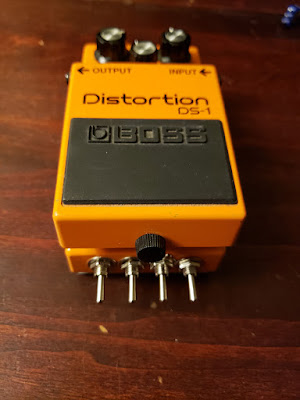That orange pedal is a classic. That's the sound I had when I started playing guitar. Out of nostalgia, I bought an old Peavey from the 80's as well as a used DS-1. It sounds like the glorious garbage from my teenage years. But something was off. The amp was even worse. So I tweaked them. Here is what I did.


The problem
First, I didn't recall the pedal tone knob to be so muffled on low setting and
shrilling on the high.
Second, it can't go clean. I'm more used to overdrives now so I have trouble
enjoying the fizz that a distortion adds to a clean sound at low gain
because of its hard clipping.
Third, it's pretty compressed and fizzy, I'm a grown up now, I need more
headroom, more bass and more crunch.
The good news is that there are easy solution for all of these problems all
over the web. Here is my version.
Clipping diodes
My experience with modding pedals is that changing the clipping diodes has
the most impact on the gain structure. I started by breadboarding some
switches. The blue switches are for changing diode types: silicon,
germanium, red LED and 3 color LED (using half of it). That selection can be
done for both sides of the clipping (clipping the top and bottom of the
signal).
Distortions often use silicon diodes. Germanium has a sligthly lower voltage
so they will start clipping sooner and thus compress the signal more. I prefer
LEDs, they start clipping at higher voltage so they give more volume and more
crunch. They also light up when they clip so you get a visual of the amount of
clipping. You can get quite fancy by combining diode types for some
asymetrical clipping.
Clean boost
The DS-1 amplifies the signal quite a lot before even hitting the opamp, so
you get clipping from the opamp itself. It's an interesting sounds and some
pedals are doing just that. But it also means that you can't lower the gain
enough to have a clean signal. So I added a switch to lower the transistor
amplification. Then you get a nice clean boost when using the level knob.
Combined with diode clipping, you get more headroom. I also like the opamp
clipping so the final iteration have the option to remove clipping diodes and
just get the opamp distortion, or just the clean sound.
Tone control
I'm not sure how we are supposed to use the extremes of the regular tone
control of a DS-1 but they sound mostly unusable to me. A nice trick is to
change the tone filter curve to make it more flat. I use a switch to turn that
mod on and off because some diode combinations are still interesting with the
original tone on high settings.
I also experimented with some mods to raise the gain a bit more but it was
adding too much hissing noise.
Packaging
For packaging these mods, my first idea was to have a separate box attached to the pedal. It looked like a motorcycle sidecar so I had a box and a design ready.
But then I figured out a way to pack the 4 toggles inside the pedal enclosure. So I decided to use some point to point soldering instead. Here you can see the diode selector. One side has red LED and germanium, the other yellow LED and silicon. The switch is 3 way, so the center is off, no diode selected.
Here's the final gut picture.
Some technical details
I experimented starting with these references:
https://www.electrosmash.com/boss-ds1-analysis
https://www.premierguitar.com/articles/boss-ds-1-mods-1?page=2
Filter switch:
- Flat filter curve: R16=1K
- Mid boost: R16=250
Gain stage bias
- Less gain: R9=25
- More gain: R9=500
Diodes
- Top: germanium, red LED, off
- Bottom: silicon, yellow LED, off
I also changed C10=.068uf to filter some shrills.
Peavey amp
The amp Supersat™is pretty bad on that Peavey Studio Pro 60. Like for the
Boss DS-1, the sound I had in my mind had more crunch than that. So I had to
modify it too.
This amp was only produced for a year so I only found schematics for the 50
and 110 versions, which appeared to be pretty different. I had to manually
trace the schematic to find the right diodes involved in the clipping. Th
egood news is that there's no difference between a pedal and an amp at this
stage. This one had 2 pairs of silicon diodes in the opamp loop. That
explains the compressed and fizzy sound. Easy to change.
Here you can see how a switch changes diodes and connects to the clipping
stage. I choose 3 gain structure: async germanium + 2 silicon, blue LEDs for
more crunch, volume and bass and a pair of MOSFET for even more headroom and
tube-like breakup.





